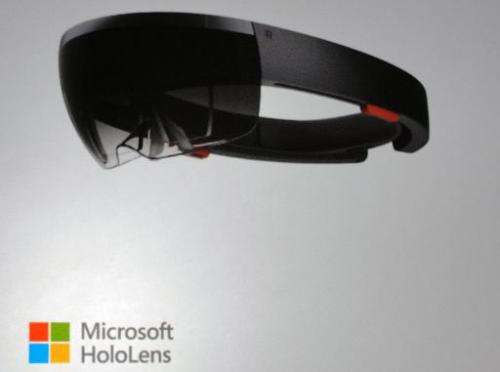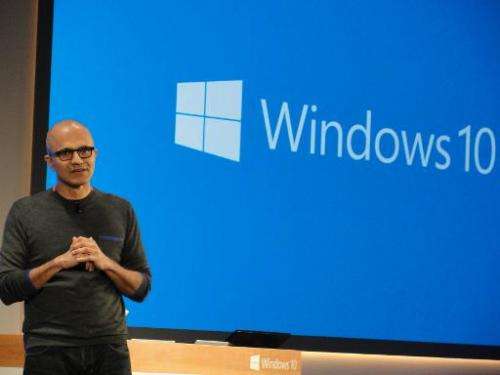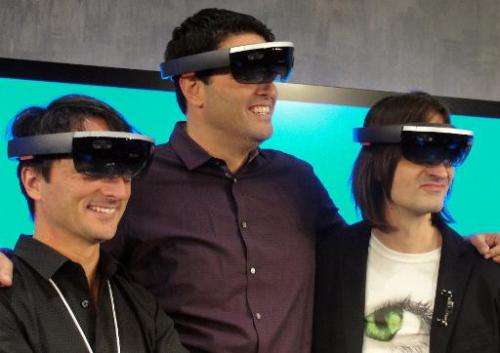Microsoft HoloLens goggles captivate with holograms

Microsoft's HoloLens goggles have hit a sweet spot between Google Glass and virtual reality headgear, immersing users in a mesmerizing world of augmented reality holograms.
The glasses, which the US technology titan sprang on an unsuspecting press this week, elicited descriptions such as "magical" and "unbelievable," the first time in a while such praise was heaped on a Microsoft creation.
The augmented reality goggles are a step in a different direction from virtual reality headgear such as Oculus Rift and Sony's Project Morpheus system, as well as Google Glass.
At private demos of HoloLens in a carefully guarded lower level of Microsoft's campus in Redmond, Washington, cameras, recording devices and even smartphones were not permitted.
Microsoft executives said the holographic capabilities built into Windows 10 operating software—to be released late this year—would open doors for developers to augment tasks from complex surgery to motorcycle design.
In a captivating demonstration, a prototype HoloLens turned a room into the surface of Mars.
HoloLens wearers found themselves standing near a 3D representation of the Rover, free to roam Mars, at times accompanied by a NASA scientist projected into the scene and communicating through Skype.
"This is the future of space exploration," said the scientist, represented by a glowing golden spacesuit reminiscent of vintage science fiction films.
NASA team members can use HoloLens to move about as if they are on Mars and figure out where they want the Rover to go and what they want it to do.
Work and play
Through a series of scenarios, HoloLens overlaid virtual scenes on real space, allowing wearers to safely and efficiently navigate rooms while engaging with 3D imagery using voice, gaze or gesture.

The head piece tracks eye movements, then lets wearers use a simple finger flick to interact with whatever they focus on.
Replacing a light switch became a collaborative effort, as one individual with a tablet computer guided the job, overlaying arrows or notes that floated in the air.
The room was then converted into an extension of the building-block themed game Minecraft, with castles on floors and table tops. With voice commands and taps of the finger, a wearer built or destroyed, and sometimes vanquished zombies.
The Microsoft headgear even became a tool for designing virtual toys then made real using a 3D printer.
HoloLens also promises scintillating integration with video games, and Microsoft has a broad and devoted fan base for Xbox consoles.
The future of computing
"HoloLens offers a new platform and experience for computing on the scale of the original PC and the launch of Apple iPhone," Forrester analyst Frank Gillett said in a blog post.
And Facebook co-founder Mark Zuckerberg has depicted virtual reality as a computing platform poised to succeed the mobile Internet era centered on smartphones and tablets.
He backed his belief by buying Oculus VR last year in a $2 billion deal.

Because virtual reality headgear disconnects users from their immediate surroundings, some people worry about what is happening in reality or what they might bump into.
"Virtual reality makes sense for gamers pretty much immediately" said Endpoint Technologies analyst Roger Kay.
"I think augmented reality is actually how this type of technology is gonna hit in to the general population."
By contrast, Google Glass essentially displays a miniature version of a smartphone screen in an upper corner of one lens.

People can glance to see text messages, video or other scenes in small displays, and also take pictures or video, controlling the eyewear with voice commands or taps on frames.
Google recently ended sales of Glass through an Explorer program, but a lower-cost and more fashionable version is expected to make it to market.
"I have to say Microsoft has truly delivered a mixed reality experience that will delight," Forrester analyst James McQuivey said in a blog post.
"It's on everybody else—from Apple to Samsung, Oculus VR to Magic Leap—to match Microsoft's opening bid."
© 2015 AFP





















